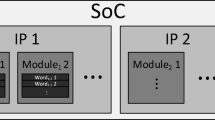Abstract
A high degree of automation is required when facing full-IC reverse engineering. In this paper, we present a methodology to delayer the chip, acquire SEM images of each layer, obtain the three-dimensional layer reconstruction, and generate a vectorized file in GDSII format for further automatic netlist extraction. A custom software tool named GDS-X has been developed to perform all the required steps from image acquisition to the GDSII file generation. Applying a novel tile mosaicking strategy and using state-of-the-art machine learning techniques for image segmentation, this software reduces dramatically the time required to complete these procedures while minimizing errors compared to old manual reverse engineering techniques.














Similar content being viewed by others
References
Chakraborty RS, Narasimhan S, Bhunia S (2009) Hardware trojan: threats and emerging solutions. In: 2009 IEEE International high level design validation and test workshop, pp 166–171. https://doi.org/10.1109/HLDVT.2009.5340158
Chen T, Guestrin C (2016) XGBoost: a scalable tree boosting system. In: Proceedings of the 22nd ACM international conference on knowledge discovery and data mining. ACM, New York, pp 785–794. https://doi.org/10.1145/2939672.2939785. http://doi.acm.org/10.1145/2939672.2939785
Chen X, Han H, Xie QW, Shen LJ (2012) Correction of SEM image distortion based on non-equidistant GM(1,1) model. In: 2012 International conference on wavelet analysis and pattern recognition, pp 20–23. https://doi.org/10.1109/ICWAPR.2012.6294748
Dura R, Pallares J, Quijada R, Formatje X, Hidalgo S, Serra-Graells F (2017) fast and robust Topology-Based logic gate identification for automated IC reverse engineering. In: Proceedings of the ISTFA 2017, Pasadena, USA, pp 317– 332
Erbagci B, Erbagci C, Akkaya NEC, Mai K (2016) A secure camouflaged threshold voltage defined logic family. In: 2016 IEEE International symposium on hardware oriented security and trust (HOST), pp 229–235. https://doi.org/10.1109/HST.2016.7495587
Hu MK (1962) Visual pattern recognition by moment invariants. IRE Trans Inf Theory 8(2):179–187. https://doi.org/10.1109/TIT.1962.1057692
Lee JH, Yoo SI (2008) An effective image segmentation technique for the SEM image. In: 2008 IEEE international conference on industrial technology, pp 1–5. https://doi.org/10.1109/ICIT.2008.4608647
Malik S, Becker GT, Paar C, Burleson WP (2015) Development of a layout-level hardware obfuscation tool. In: 2015 IEEE computer society annual symposium on VLSI, pp 204–209. https://doi.org/10.1109/ISVLSI.2015.118
Otsu N (1979) A threshold selection method from Gray-Level histograms. IEEE Trans Syst Man Cybern 9 (1):62–66. https://doi.org/10.1109/TSMC.1979.4310076
Principe E, Asadizanjani N, Forte D, Tehranipoor M, Chivas R, DiBattista M, Silverman S (2017) Plasma FIB deprocessing of integrated circuits from the backside. Electronic Device Failure Analysis 19:36–44
Quadir SE, Chen J, Forte D, Asadizanjani N, Shahbazmohamadi S, Wang L, Chandy J, Tehranipoor M (2016) A survey on chip to system reverse engineering. J Emerg Technol Comput Syst 13 (1):6:1–6:34. https://doi.org/10.1145/2755563. http://doi.acm.org/10.1145/2755563
Ronneberger O, Fischer P, Brox T (2015) U-Net: convolutional networks for biomedical image segmentation. ArXiv e-prints
Siah YW, Hong YJ, Liu Q, Kor HB, Gan CL (2013) Uniform delayering of copper metallization. In: Proceedings of the 20th IEEE international symposium on the physical and failure analysis of integrated circuits (IPFA), pp 166–169. https://doi.org/10.1109/IPFA.2013.6599147
Torrance R, James D (2011) The state-of-the-art in semiconductor reverse engineering. In: 2011 48Th ACM/EDAC/IEEE design automation conference (DAC), pp 333–338
Yu-Bo X, Ping Y, Yong-Xi G (2008) On the graph-based panorama construction for 2D large-scale microscope images. Int Arch Photogramm Remote Sens Spat Inf Sci XXXVII(B5):711–718
Zudhistira D, Viswanathan V, Narang V, Chin J, Novotny K, Vincen Oboňa J, Sharang S (2017) Precision Xe plasma FIB delayering for physical failure analysis of sub-20 nm microprocessor devices. In: Proceedings of the ISTFA 2017, Pasadena, USA, pp 593–598
Acknowledgements
The authors would like to thank the IMB-CNM clean room staff and specially the RIE, SEM image acquisition and carbon deposition teams for their valuable support and advice.
Author information
Authors and Affiliations
Corresponding author
Additional information
This work has been partially funded by D+T Microelectronica A.I.E.
Rights and permissions
About this article
Cite this article
Quijada, R., Dura, R., Pallares, J. et al. Large-Area Automated Layout Extraction Methodology for Full-IC Reverse Engineering. J Hardw Syst Secur 2, 322–332 (2018). https://doi.org/10.1007/s41635-018-0051-4
Received:
Accepted:
Published:
Issue Date:
DOI: https://doi.org/10.1007/s41635-018-0051-4




